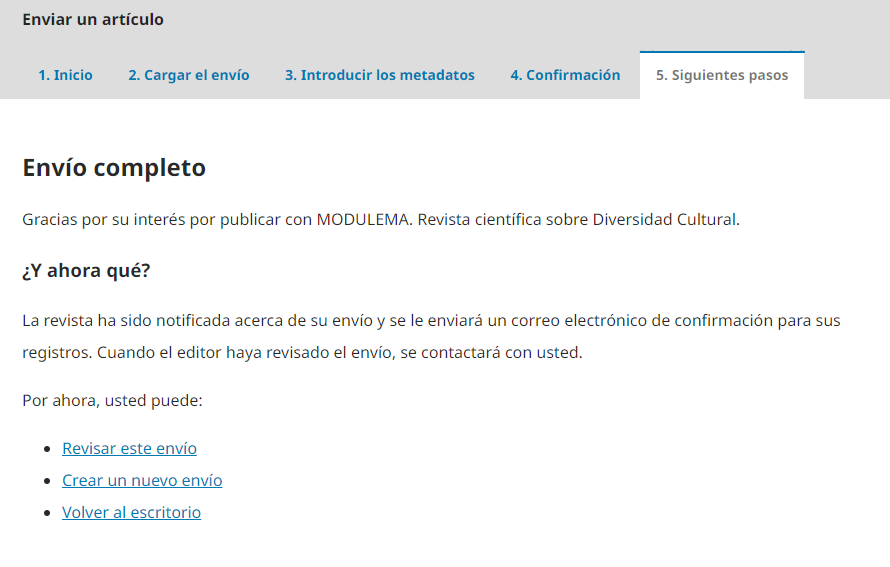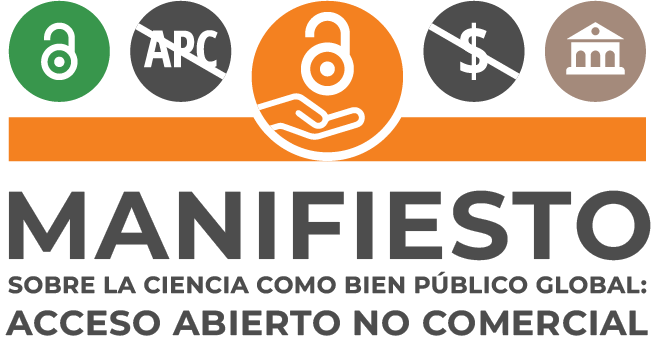ISSN-e: 2530-934X
DOI: 10.30827/modulema
Submissions
Submission Preparation Checklist
As part of the submission process, authors are required to check off their submission's compliance with all of the following items, and submissions may be returned to authors that do not adhere to these guidelines.- The submission has not been previously published, nor is it before another journal for consideration (or an explanation has been provided in Comments to the Editor).
- The submission file is in OpenOffice, Microsoft Word, or RTF document file format.
- Where available, URLs for the references have been provided.
-
The text is single-spaced; the font size is 12 points; italics are used instead of underlining (except for URLs); and all illustrations, figures, and tables are placed within the text and not at the end of the text.
-
The text complies with the bibliographic and style requirements indicated in the Style Guidelines, which can be found in the section About the journal.
- If you are submitting to a peer-reviewed section of the journal, you must ensure that the instructions in "Ensuring a blind review" have been followed.
Articles
The articles must be original and unpublished, and must not be in the process of being evaluated or committed to any other publication. With regard to the content, they must refer to a topic related to Cultural Diversity.
For the writing of the articles, the author must adhere to the specific template designed for this purpose, the structure being as follows:
- Title of the article. The Title will be included in Spanish and English and, if the article is written in another language, a third one in the original language will be included.
- Authors. Full name and surname, according to the order of signature. If they belong to different centres or institutions, a call will be made by means of a number. For example: Ana Gómez Pérez1, Juan González Fernández2. The author responsible for the article must have an ORCID Digital Identifier. This may also be included for the rest of the authors.
- Department/Centre/Institution. Cite them in the order of the number overleaf in the previous section.
- E-mail address. It must be the main author's e-mail address. The e-mail addresses of the other authors may also be included.
- Abstract. It will have a limit of 250 words. It must be clear and concise, indicating the relevant information to be communicated, following the IMRYD format: Introduction, which will include the objective or purpose of the research; Methodology, which will include the basic procedures (design, selection of samples or cases, methods and techniques of experimentation or observation and analysis); Results, main findings (give specific data and their statistical significance, where appropriate); and Discussion and conclusions. The abstract should be written in Spanish and English and, if the article is written in another language, a third one in the original language should be included.
- Key words. Between 3 and 5 words should be included, separated by commas, following the UNESCO Thesaurus. They will be included after each abstract in Spanish and English and, if the article is written in another language, they will also be included after the abstract in the original language.
- Body of the article. It will be between 4000 and 6000 words long. It will contain the following sections: Introduction (the objectives of the work will be detailed at the end), Methodology, Results, Discussion and Conclusions, Acknowledgements (if any), and Bibliographical references, which will be presented in alphabetical order and must conform to APA standards (www.apastyle.org). The style guide of the journal can be consulted at the website.
- Brief Curriculum Vitae. It must be submitted by all authors. In a maximum of 100 words, the full name, academic training, place of work, lines of research and recent publications or publications of interest should be stated. In this case it is only necessary to indicate the title, publisher or journal and year of publication. Optionally, a recent ID-sized photograph may be attached.
Bibliographical reviews
This type of text analyses, with a critical view, a recently published work of special interest for the subject of the journal.
The publication of the work reviewed shall not be more than three years after the publication date of the journal.
For the writing of bibliographical reviews, the author must adhere to the specific template designed for this purpose, following the following structure:
Title of the work reviewed. The bibliographic data must be provided (in the case of an article in a journal: author, year, title of publication, journal with its volume and page number at the beginning and end, and its ISSN; in the case of a book: author, year, title of publication, city, publisher and ISBN). In addition, an image of the cover (title page) and of the page containing the editorial data is required (jpg format, resolution 72 pp, size 320x280 px).
- Subtitle (if any)
- Signature. Name and surname of the author of the review.
- Author's institutional affiliation details. Institution, centre, city and country of the institution where he or she works.
- Content. The length of the review must not exceed 1000 words, from the title to the bibliographical references. The font should be Times New Roman, 12 point, 1.5 line spacing.
- Bibliographical references. Other bibliographical references may be included if they appear in the text. In this case, they will be presented in alphabetical order and must conform to APA standards (www.apastyle.org). The journal's style guide can be consulted.
- Brief Curriculum Vitae of the author of the review indicating, in a maximum length of 100 words, full name, academic background, place of work, lines of research, and recent publications or publications of interest. In this case it is only necessary to indicate the title, publisher or journal and year of publication. Optionally, a recent ID-sized photograph may be attached.
Research work
Summaries of research work carried out in doctoral theses, master's theses and bachelor's theses on any subject related to Cultural Diversity.
It will follow the same structure and criteria as the articles.
In addition, the last page will include the summary poster used for the defence of the work, if any.
Copyright Notice
MODULEMA Journal provides unrestricted open access to its contents from the moment of publication in the journal. In addition, all articles are incorporated into the DIGIBUG Institutional Repository of the University of Granada. All contents are distributed under a Creative Commons Attribution-NonCommercial-ShareAlike 4.0 International (CC BY NC SA 4.0) licence. The legal text of the licence can be found at the following link.

Privacy Statement
The names and email addresses entered in this journal site will be used exclusively for the stated purposes of this journal and will not be made available for any other purpose or to any other party.

























